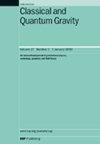Real-time methods in JT/SYK holography
IF 3.6
3区 物理与天体物理
Q2 ASTRONOMY & ASTROPHYSICS
引用次数: 0
Abstract
We study the conventional holographic recipes and its real-time extensions in the context of the correspondence between Sachdev–Ye–Kitaev quantum mechanics and JT gravity. We first observe that only closed contours are allowed to have a 2d space-time holographic dual and standard holographic formulas. Thus, in a real-time formulation of the duality, the boundaries of a classical connected geometry are a set of closed curves, parameterized by a complex time contour as in the Schwinger–Keldysh framework. In this context, a consistent extension of the standard holographic formulas can be proposed, describing the (real-time) correspondence between gravity and boundary quantum models that include averaging on the coupling constants. We investigate the proposed prescription in different AdS solutions with Schwinger–Keldysh boundary condition, dual to a boundary quantum theory at finite temperature defined on a complex time contour, and consider also classical, asymptotically AdS solutions (wormholes) with two disconnected boundaries. In doing this, we revisit the so-called factorization problem, and its resolution in conventional holography by virtue of some (non-local) coupling between disconnected boundaries, and we show how in specific contexts, the averaging proposal by-passes the paradox as well, since it induces a similar effective coupling.JT/SYK 全息技术中的实时方法
我们在萨克德夫-叶-基塔埃夫量子力学与 JT 引力的对应关系中研究了传统的全息公式及其实时扩展。我们首先观察到,只有封闭轮廓才允许有二维时空全息对偶和标准全息公式。因此,在对偶性的实时表述中,经典连通几何的边界是一组封闭曲线,其参数是施文格-凯尔迪什框架中的复时间等值线。在这种情况下,可以提出标准全息公式的一致扩展,描述引力与边界量子模型之间的(实时)对应关系,其中包括耦合常数的平均值。我们在具有施文格-凯尔迪什边界条件的不同 AdS 解决方案中研究了所提出的公式,这些解决方案与定义在复杂时间等值线上的有限温度边界量子理论是对偶的,我们还考虑了具有两个断开边界的经典渐近 AdS 解决方案(虫洞)。在此过程中,我们重温了所谓的因式分解问题,以及传统全息术中凭借断开边界之间的某种(非局部)耦合来解决这一问题的方法,并展示了在特定情况下,平均化提议如何也能绕过这一悖论,因为它诱发了类似的有效耦合。
本文章由计算机程序翻译,如有差异,请以英文原文为准。
求助全文
约1分钟内获得全文
求助全文
来源期刊

Classical and Quantum Gravity
物理-天文与天体物理
CiteScore
7.00
自引率
8.60%
发文量
301
审稿时长
2-4 weeks
期刊介绍:
Classical and Quantum Gravity is an established journal for physicists, mathematicians and cosmologists in the fields of gravitation and the theory of spacetime. The journal is now the acknowledged world leader in classical relativity and all areas of quantum gravity.
 求助内容:
求助内容: 应助结果提醒方式:
应助结果提醒方式:


